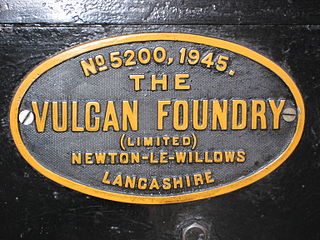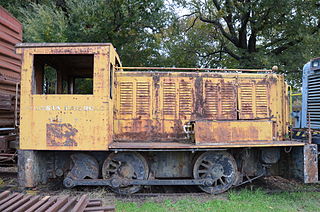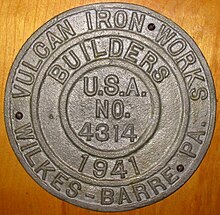
A locomotive is a rail transport vehicle that provides the motive power for a train. If a locomotive is capable of carrying a payload, it is usually rather referred to as a multiple unit, motor coach, railcar or power car; the use of these self-propelled vehicles is increasingly common for passenger trains, but rare for freight trains.

The American Locomotive Company was an American manufacturer that operated from 1901 to 1969, initially specializing in the production of locomotives but later diversifying and fabricating at various times diesel generators, automobiles, steel, tanks, munitions, oil-production equipment, as well as heat exchangers for nuclear power plants.

Baldwin Locomotive Works (BLW) was an American manufacturer of railway locomotives from 1825 to 1951. Originally located in Philadelphia, Pennsylvania, it moved to nearby Eddystone in the early 20th century. The company was for decades the world's largest producer of steam locomotives, but struggled to compete when demand switched to diesel locomotives. Baldwin produced the last of its 70,000-plus locomotives in 1951, before merging with the Lima-Hamilton Corporation on September 11, 1951, to form the Baldwin-Lima-Hamilton Corporation.

H.K. Porter, Inc. (Porter) manufactured light-duty railroad locomotives in the US, starting in 1866. The company became the largest producer of industrial locomotives, and built almost eight thousand of them. The last locomotive was built in 1950, but the company continues to produce industrial equipment to this day.

Vulcan Iron Works was the name of several iron foundries in both England and the United States during the Industrial Revolution and, in one case, lasting until the mid-20th century. Vulcan, the Roman god of fire and smithery, was a popular namesake for these foundries.

The Vulcan Foundry Limited was an English locomotive builder sited at Newton-le-Willows, Lancashire.

The 2-6-6-6 is an articulated locomotive type with two leading wheels, two sets of six driving wheels and six trailing wheels. Only two classes of the 2-6-6-6 type were built. One was the "Allegheny" class, built by the Lima Locomotive Works. The name comes from the locomotive's first service with the Chesapeake and Ohio Railway beginning in 1941, where it was used to haul loaded coal trains over the Allegheny Mountains. The other was the "Blue Ridge" class for the Virginian Railway. These were some of the most powerful reciprocating steam locomotives ever built, at 7,500 hp, and one of the heaviest at 386 tons for the locomotive itself plus 215 tons for the loaded tender.

Ruston & Hornsby was an industrial equipment manufacturer in Lincoln, England founded in 1918. The company is best known as a manufacturer of narrow and standard gauge diesel locomotives and also of steam shovels. Other products included cars, steam locomotives and a range of internal combustion engines, and later gas turbines. It is now a subsidiary of Siemens.

The United States Army Transportation Corps (USATC) S100 Class is a 0-6-0 steam locomotive that was designed for switching (shunting) duties in Europe and North Africa during World War II. After the war, they were used on railways in Austria, China, Egypt, France, Great Britain, Greece, Iran, Iraq, Israel, Italy, the Netherlands, Palestine, the United States, and Yugoslavia.
Indian Railways operates India's railway system and comes under the purview of the Ministry of Railways of Government of India. As of 2023, it maintains over 108,706 km (67,547 mi) of tracks and operates over 13,000 trains daily with a fleet of 14,800 locomotives. The railways primarily operates a fleet of electric and diesel locomotives along with a few compressed natural gas (CNG) locomotives. Steam locomotives are operated on mountain railways and on heritage trains.

Dickson Manufacturing Company was an American manufacturer of boilers, blast furnaces and steam engines used in various industries but most known in railway steam locomotives. The company also designed and constructed steam powered mine cable hoists. It was founded in Scranton, Pennsylvania by Thomas Dickson in 1856. In total, the company produced 1,334 steam locomotives until it was taken over by ALCO in 1901.

W. G. Bagnall was a locomotive manufacturer from Stafford, England which was founded in 1875 and operated until it was taken over in 1962 by English Electric.

The Turkish State Railways (TCDD) 56301 Class is a class of 2-10-0 steam locomotives known as "Skyliners". They were built by Vulcan Iron Works of Wilkes-Barre, Pennsylvania. The 88 locomotives in this class were numbered 56301-88. The first arrived in 1947.

The Lumberjack Steam Train is a passenger excursion train operated on the Laona and Northern Railway, a heritage railroad located in Laona, Wisconsin and part of the Camp 5 Museum. It is operated by the non-profit Camp 5 Museum Foundation, Inc. The train runs 3 miles (4.8 km) from the outskirts of Laona to the museum site.

Maumelle Ordnance Works Locomotive 1 is a gasoline-powered, mechanically driven, two-axle railway locomotive which was built in 1942 by Vulcan Iron Works for the United States War Department's Maumelle Ordnance Works. It was added to the U.S. National Register of Historic Places in 2006 and is preserved at the Fort Smith Trolley Museum.

The Commonwealth Railways NB class originated in a shipment of four 0-6-0, 1067 millimetres gauge, saddle tank steam locomotives built by the Vulcan Iron Works of Wilkes-Barre, Pennsylvania. They were imported to Australia in 1916 for construction work at the naval base at Henderson, Western Australia. Their tractive effort was 9500 pounds.

A mine railway, sometimes pit railway, is a railway constructed to carry materials and workers in and out of a mine. Materials transported typically include ore, coal and overburden. It is little remembered, but the mix of heavy and bulky materials which had to be hauled into and out of mines gave rise to the first several generations of railways, at first made of wooden rails, but eventually adding protective iron, steam locomotion by fixed engines and the earliest commercial steam locomotives, all in and around the works around mines.

Crown Metal Products was a manufacturer of railroad rolling stock based in Wyano, Pennsylvania. The company was founded by Ken Williams in 1946 and initially sold pot cleaners and then electric fence wires and other products. In 1959, the company began to transition into producing narrow gauge locomotives, a personal interest of Williams. The company went on to produce steam locomotives and passenger cars of various sizes for amusement park railroads. The firm ceased production in 1989; however, much of its rolling stock continues to operate at various locations around the world.

The Manila Railroad 800 class USA were 45 United States Army Transportation Corps class S118 steam locomotives used by the Manila Railroad Company and the Philippine National Railways. Originally built by Vulcan Iron Works and the American Locomotive Works for the United States Army during the Second Philippines Campaign, they were later used to pull freight trains and temporary passenger trains. After the dieselization of the Manila Railroad network in the mid-1950s, they were relegated to work trains until the last unit was scrapped after appearing in a 1989 World War II movie.



















